中国文化英文PPT之龙文化dragon culture in China
- 格式:ppt
- 大小:12.45 MB
- 文档页数:46
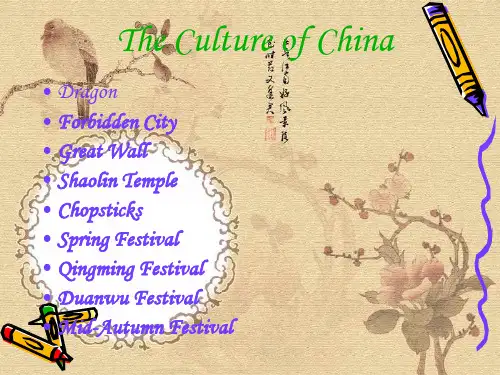
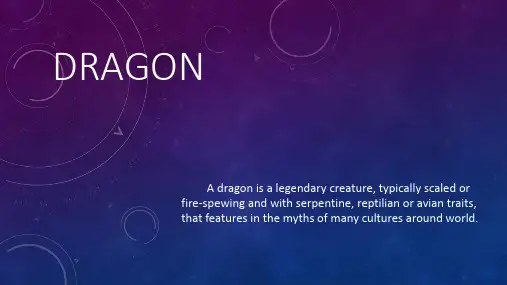
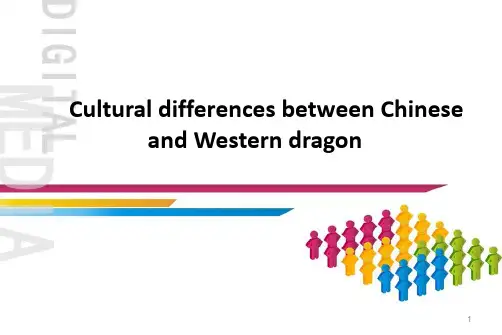
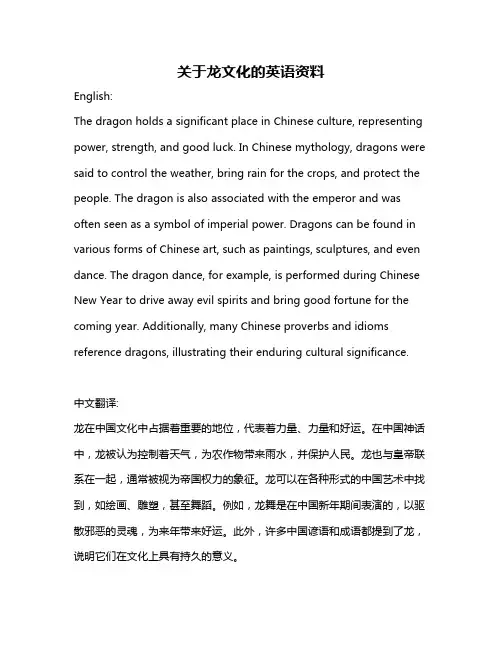
关于龙文化的英语资料English:The dragon holds a significant place in Chinese culture, representing power, strength, and good luck. In Chinese mythology, dragons were said to control the weather, bring rain for the crops, and protect the people. The dragon is also associated with the emperor and was often seen as a symbol of imperial power. Dragons can be found in various forms of Chinese art, such as paintings, sculptures, and even dance. The dragon dance, for example, is performed during Chinese New Year to drive away evil spirits and bring good fortune for the coming year. Additionally, many Chinese proverbs and idioms reference dragons, illustrating their enduring cultural significance.中文翻译:龙在中国文化中占据着重要的地位,代表着力量、力量和好运。
在中国神话中,龙被认为控制着天气,为农作物带来雨水,并保护人民。
龙也与皇帝联系在一起,通常被视为帝国权力的象征。
龙可以在各种形式的中国艺术中找到,如绘画、雕塑,甚至舞蹈。
例如,龙舞是在中国新年期间表演的,以驱散邪恶的灵魂,为来年带来好运。
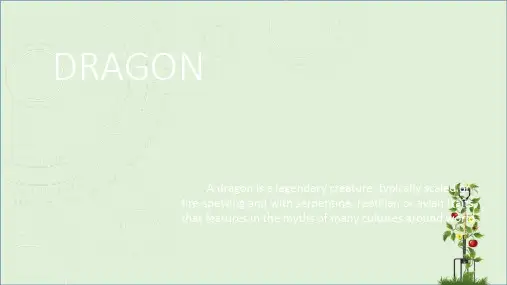
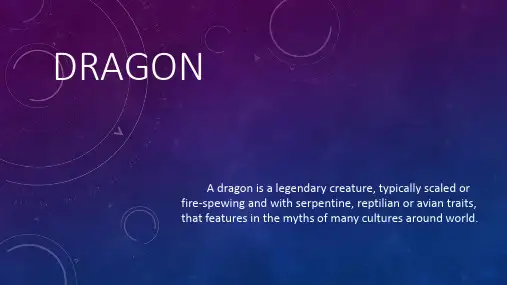
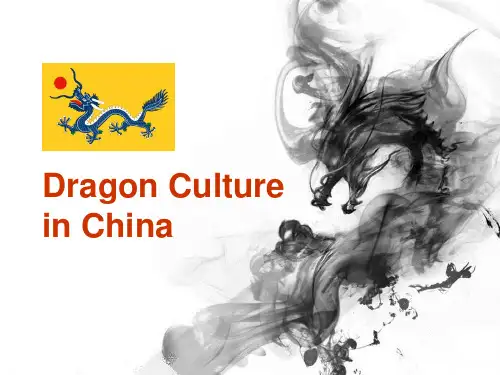
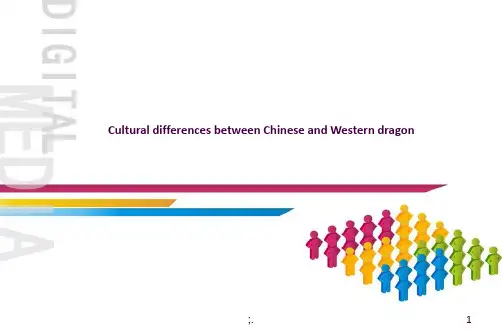
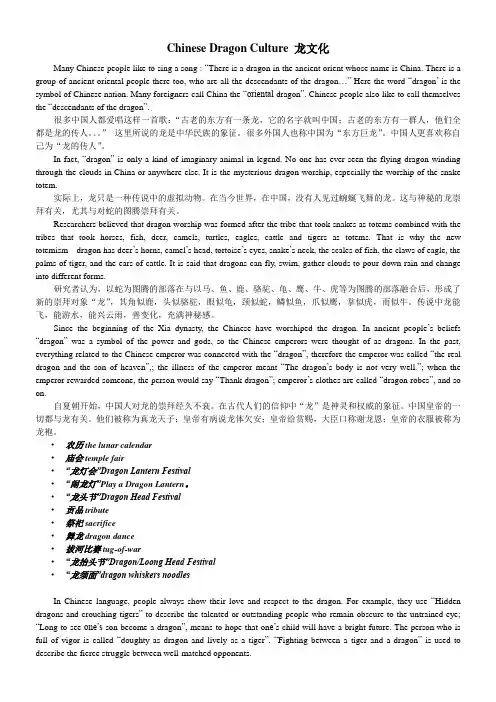
Chinese Dragon Culture 龙文化Many Chinese people like to sing a song : “There is a dragon in the ancient orient whose name is China. There is a group of ancient oriental people there too, who are all the descendants of the dragon…” Here the word “dragon’ is the symbol of Chinese nation. Many foreigners call China the “oriental dragon”. Chinese people also like to call themselves the “descendants of the dragon”.很多中国人都爱唱这样一首歌:“古老的东方有一条龙,它的名字就叫中国;古老的东方有一群人,他们全都是龙的传人。
”这里所说的龙是中华民族的象征。
很多外国人也称中国为“东方巨龙”。
中国人更喜欢称自己为“龙的传人”。
In fact, “dragon” is only a kind of imaginary animal in legend. No one has ever seen the flying dragon winding through the clouds in China or anywhere else. It is the mysterious dragon worship, especially the worship of the snake totem.实际上,龙只是一种传说中的虚拟动物。
在当今世界,在中国,没有人见过蜿蜒飞舞的龙。
这与神秘的龙崇拜有关,尤其与对蛇的图腾崇拜有关。
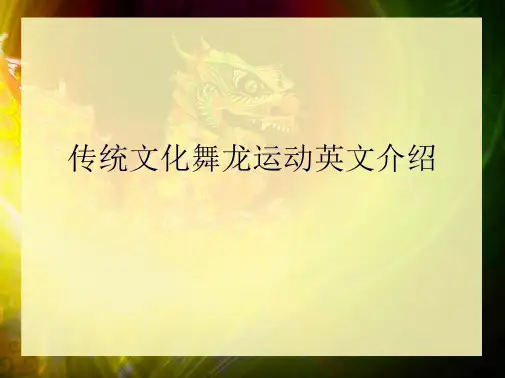

关于龙的中国文化的英文一年级Title: The Cultural Significance of Dragons in Chinese TraditionDragons are deeply ingrained in Chinese culture, symbolizing power, strength, and good fortune. In Chinese mythology and folklore, dragons are revered creatures with significant cultural symbolism. From ancient times to the present day, the dragon holds a prominent place in various aspects of Chinese life, including art, literature, festivals, and even astrology.In Chinese mythology, dragons are believed to be divine creatures associated with water, rain, and fertility. Theyare often depicted as long, serpentine beings with scaled bodies and majestic features. Unlike the fire-breathing dragons of Western folklore, Chinese dragons are benevolent beings that bring prosperity and protection.One of the most iconic symbols of China is the dragon dance, often performed during festive occasions such as Chinese New Year celebrations. The dragon dance involves a team of performers manipulating a long, dragon-shaped puppet, which undulates and dances to the beat of drums and cymbals. This traditional dance is believed to bring good luck and ward off evil spirits, making it an integral part of Chinese cultural festivities.Dragons also feature prominently in Chinese art and architecture. From ancient pottery and paintings to modern-day sculptures and buildings, dragons adorn countlessartifacts and structures throughout China. In traditional Chinese architecture, dragons are often carved into pillars, roofs, and doorways as protective guardians, symbolizing strength and auspiciousness.In addition to their symbolic significance, dragons play a crucial role in Chinese astrology. The Chinese zodiacfeatures twelve animals, with each year associated with a specific animal sign. The dragon is one of these twelve zodiac animals and is considered a highly auspicious sign associated with success, wealth, and leadership. People born in the Year of the Dragon are believed to possess the dragon's noble traits and are often seen as natural leaders.Moreover, dragons hold a special place in Chinese literature and folklore, appearing in countless myths, legends, and stories passed down through generations. These tales often depict dragons as wise and powerful beings, capable of both benevolence and wrath. One famous story is the legend of the Dragon Gate, where carp transform into dragons after leaping over a waterfall, symbolizing perseverance and transformation.In Chinese culture, the dragon is not merely a mythical creature but a symbol of the nation's resilience, vitality, and enduring spirit. Its presence in various aspects ofChinese life reflects the profound influence of traditional beliefs and values on contemporary society. Whether in art, literature, festivals, or astrology, the dragon continues to captivate imaginations and inspire reverence among the Chinese people, serving as a timeless emblem of strength and prosperity.。
关于中国龙文化的英语小报Title: Unveiling the Mysteries of Chinese Dragon CultureIntroduction:The Chinese dragon is an iconic symbol deeply rooted in the country"s rich cultural heritage.With a history spanning thousands of years, the dragon represents power, wisdom, and prosperity.In this English newsletter, we will explore the fascinating aspects of Chinese dragon culture, shedding light on its significance in various aspects of Chinese society.1.Origins and Symbolism:The Chinese dragon, known as "Long" in Mandarin, holds a unique position in Chinese mythology.It is believed to be the divine ancestor of the Chinese nation and symbolizes imperial power and prosperity.The dragon is often depicted as a long, scaled creature with horns, claws, and the ability to control the weather and water.2.Dragon in Chinese History:Throughout Chinese history, the dragon has been closely associated with the emperors, who were considered the sons of heaven.The imperial throne was known as the "Dragon Throne," and the emperors wore robes adorned with dragon patterns.The dragon was also used as a symbol of authority on flags, coins, and official documents.3.Dragon in Chinese Art and Architecture:Chinese dragon motifs are prevalent in traditional art and architecture.You can find intricate dragon carvings on the roofs of ancient temples, palaces, and gardens.In traditional Chinese painting, the dragon is often depicted among clouds and water, symbolizing its divine power over the elements.4.Dragon in Folklore and Festivals:In Chinese folklore, the dragon is associated with various myths and legends.One of the most famous stories is about the Dragon Boat Festival, which commemorates the death of the great poet Qu Yuan.Dragon boat races are held to honor his memory, with participants racing in long, narrow boats decorated with dragon heads and tails.5.Modern Influence of Dragon Culture:Today, the Chinese dragon continues to influence contemporary culture.It is commonly used in branding, logos, and advertising to symbolize strength, prosperity, and good fortune.The dragon is also celebrated in Chinese martial arts, literature, and cinema, maintaining its cultural relevance in modern society.Conclusion:The Chinese dragon is a multifaceted symbol that has captivated the hearts and minds of people for centuries.Its influence on Chinese culture is profound, extending to art, history, folklore, and modern-daysociety.By exploring the rich tapestry of dragon culture, we gain a deeper understanding of China"s cultural heritage and the enduring significance of this legendary creature.。
小学英语作文介绍中国龙文化Title: The Majestic Dragon Culture of ChinaDeep within the rich tapestry of Chinese culture, there lurks a mythical beast that has captured the imaginations of people for centuries. This beast is none other than the dragon, a symbol of power, wisdom, and good fortune in Chinese folklore. The dragon culture in China is a fascinating blend of mythology, art, and tradition, reflecting the unique spirit and values of the Chinese people.The dragon in Chinese mythology is often depicted as a scaled, serpentine creature with horns, claws, and a fiery breath. It is a benevolent being, associated with bringing rain and fertility to the land. In ancient times, the dragon was worshipped as a deity, and temples and shrines were dedicated to its veneration. The emperors of China often claimed descent from the dragon, symbolizing their divine right to rule.The dragon culture is also reflected in various forms of Chinese art. In paintings, the dragon is often depictedin a majestic pose, surrounded by clouds and flames. Sculptors have also created intricate dragon carvings, which are often found on temples, palaces, and other important buildings. The dragon is also a popular motif in Chinese ceramics, textiles, and jade carvings.Moreover, the dragon culture is deeply ingrained in Chinese festivals and traditions. The Dragon Boat Festival, celebrated on the fifth day of the fifth lunar month, is one such example. This festival commemorates the ancient Chinese patriot Qu Yuan and features dragon boat races, where teams paddle long, dragon-headed boats in a thrilling competition. These boats are often decorated with vibrant dragon motifs, further emphasizing the importance of the dragon in Chinese culture.In modern times, the dragon has become a global icon representing China and its rich heritage. The Beijing Olympics in 2008, for instance, featured a stunning opening ceremony that showcased the splendor of Chinese dragon culture. The Olympic mascots, known as the Fuwa, were also inspired by the dragon and other traditional Chinese elements.The dragon culture in China is not just a symbol of the past but also a vibrant and evolving aspect of contemporary society. Many Chinese people still believe that dragons bring good luck and prosperity, and they often hang dragon-themed decorations in their homes or offices. The dragon is also a popular theme in modern Chinese literature, film, and television, keeping the legend alive for new generations.In conclusion, the dragon culture of China is a multifaceted and fascinating aspect of the country's rich heritage. It embodies the spirit of power, wisdom, and good fortune, and has been a source of inspiration and wonderfor people throughout the ages. As China continues to grow and develop, its dragon culture will remain an enduring symbol of the nation's unique identity and spirit.。